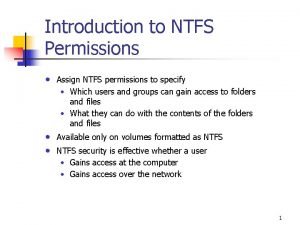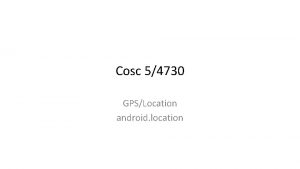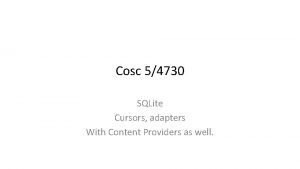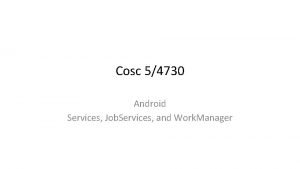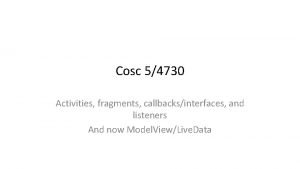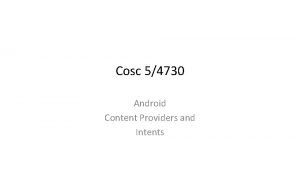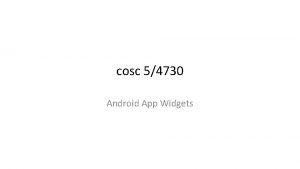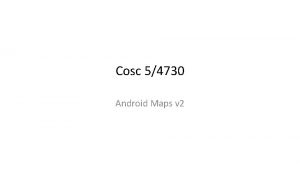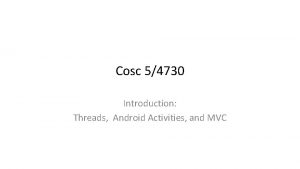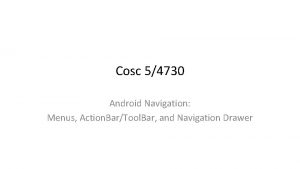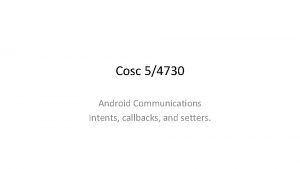Cosc 54730 Permissions Permissions Note that all of























- Slides: 23

Cosc 5/4730 Permissions

Permissions Note that all of start with android. permission. • Location: – • About “cell” Network – • BLUETOOTH, BLUETOOTH_ADMIN, Accounts: (Account. Manager) – • BIND_INPUT_METHOD (Input. Method. Service), BIND_REMOTEVIEWS (Remote. Views. Service), BIND_TEXT_SERVICE (Text. Service like spellcheckerservice), BIND_VPN_SERVICE (Vpn. Service), BIND_WALLPAPER (Wallpaper. Service) Bluetooth – • BATTERY_STATS, CALL_PHONE, CAMERA, MODIFY_AUDIO_SETTINGS, NFC, READ_EXTERNAL_STORAGE, WRITE_EXTERNAL_STORAGE, RECEIVE_BOOT_OCMPLETED, RECORD_AUDIO, VIBRATE, WAKE_LOCK (prevent screen from dimming and lock), Varying services – • ACCESS_NETWORK_STATE, ACCESS_WIFI_STATE, CHANGE_NETWORK_STATE, CHANGE_WIFI_MULITCAST_STATE, CHANGE_WIFI_STATE, INTERNET (needed to use networking) Hardware: – • ACCESS_COARSE_LOCATION, ACCESS_FINE_LOCATION, ACCESS_LOCATION_EXTRA_COMMANDS, ACCESS_MOCK_LOCATION GET_ACCOUNTS, MANAGE_ACCOUNTS, USER_CREDENTIALS Text messaging – READ_SMS, RECEIVE_MMS, SEND_SMS, WRITE_SMS

Permissions (2) • User “information”: – READ_CALENDAR, WRITE_CALENDAR, READ_CONTACTS, WRITE_CONTACTS, READ_USER_DICTIONARY, WRTIE_USER_DICTIONARY – READ_HISTORY_BOOKMARKS, WRITE_HISTORY_BOOKMARKS, – READ_SOCIAL_STREAM, SUBSCRIBE_FEEDS_READ, SUBSCRIBE_FEEDS_WRITE, WRITE_SOCAIL_STREAM, – READ_SYNC_SETTINGS, READ_SYNC_STATS, WRITE_SYNC_SETTINGS, – SET_ALARM, USE_SIP, WRITE_SETTINGS (system settings), RECEIVE_WAP_PUSH, SET_TIME_ZONE – SET_WALLPAPER, SET_WALLPAPER_HINTS – READ_PROFILE and WRITE_PROFILE (user’s personal profile data) • Phone calls: – READ_PHONE_STATE, READ_CALL_LOG, WRITE_CALL_LOG, PROCESS_OUTGOING_CALLS • Mostly depreciated as of API 30 (android 11) for Call. Screening. Service. • Running applications (and recent apps too). – GET_TASKS, REORDER_TASKS

Other Misc Permissions • ADD_VOICEMAIL – Added in API level 14, app must have access to a voicemail server. – Constant Value: "com. android. voicemail. permission. ADD_VOICEMAIL" • DISABLE_KEYGUARD, EXPAND_STATUS_BAR • FLASHLIGHT, GET_PACKAGE_SIZE • KILL_BACKGROUND_PROCESSES – Added in API level 8 – Allows an application to call kill. Background. Processes(String)

Other permissions. • I skipped over all the “system” permissions. – Says, “Not for use by third-party applications. ” in the documentation. • Your app must be a system level app, which you can’t do without rooting your phone or becoming a vendor, like say Motorola or Samsung. – http: //stackoverflow. com/questions/14256687/how-to-make-myapplication-system

Calendar Example • Once a calendar is connected to the device • You can use the following example from google to read/write to the calendar – Uses the Calendar Provider • http: //developer. android. com/guide/topics/providers/calenda r-provider. html

Contacts Example • Same with contacts • http: //developer. android. com/guide/topics/providers/contacts -provider. html

User Dictionary • Android use the user dictionary for the example in the “content provider basics” example. • http: //developer. android. com/guide/topics/providers/content -provider-basics. html

Account. Manager • Provides a centralized registry of the user online accounts – Example: Facebook, dropbox, Evernote, etc… – There are some examples of how to use and create your “account” for your online service. • http: //www. finalconcept. com. au/article/view/android-account-manager-step -by-step • http: //developer. android. com/reference/android/accounts/Account. Manager. html

Incoming/outgoing phone calls • deprecated as of API 29. Uses a callscreeningservice, that is built into the app dialer, until api 29 which is buggy, but can be separate. • Uses: PROCESS_OUTGOING_CALLS and READ_PHONE_STATE • The example uses two Broadcast Receivers – You can do it in one, but split for the example. – Able to get the phone number and the information. – http: //androidlabs. org/short-experiments/broadcast-receivers/processoutgoing-calls/ • This example also shows you have to change the incoming phone number! – http: //code. google. com/p/krvarma-androidsamples/source/browse/trunk/Detect. Calls/? r=37

Incoming/outgoing phone calls (2) • You can block outgoing phone calls – You use: set. Result. Data(null); – That will stop the outbound call! • http: //stackoverflow. com/questions/599443/hang-up-outgoing-call-in-android – You can not drop/ignore incoming calls thought. Requires the MODIFY_PHONE_STATE permission, which is a system level permission. • http: //stackoverflow. com/questions/15012082/rejecting-incoming-call-in-android • http: //androidsourcecode. blogspot. in/2010/10/blocking-incoming-call-android. html

Call. Screening. Service • Started in API 24 – But had to be part of the dialer. • As of API 29 (android 10), the screener could be separate. – Allows you disallow incoming calls, plus reject (hang up), no notifications, and no logging in the dialer – in API 29 added no ring option, which is a standard option. • https: //developer. android. com/reference/kotlin/android/telec om/Call. Screening. Service

android. xml file <service android: name="your. package. Your. Call. Screening. Service. Implementation" android: permission="android. permission. BIND_SCREENING_SERVICE"> <intent-filter> <action android: name="android. telecom. Call. Screening. Service"/> </intent-filter> </service>

main activity and permissions. • You'll need to request permission to be the screener. So something like this: private static final int REQUEST_ID = 1; public void request. Role() { Role. Manager role. Manager = (Role. Manager) get. System. Service(ROLE_SERVICE); Intent intent = role. Manager. create. Request. Role. Intent(Role. Manager. ROLE_CALL_SCREENING); start. Activity. For. Result(intent, REQUEST_ID); } @Override public void on. Activity. Result(int request. Code, int result. Code, Intent data) { if (request. Code == REQUEST_ID) { if (result. Code == android. app. Activity. RESULT_OK) { // Your app is now the call screening app } else { // Your app is not the call screening app } } }

The service. public class my. Call. Screening. Service extends Call. Screening. Service { public my. Call. Screening. Service() {} //constructor @Override public void on. Screen. Call(@Non. Null Call. Details call. Details) { if (call. Details. get. Call. Direction() == Call. Details. DIRECTION_INCOMING) { String num = call. Details. get. Handle(). get. Scheme. Specific. Part(); String phonenumber = Phone. Number. Utils. format. Number(num, Locale. get. Default(). get. Country()); //now make a decision on how to responsetocall if (call. Details. get. Call. Direction() == Call. Details. DIRECTION_OUTGOING) { //you can't change out going calls, but you can look the numbers and stuff. } else { //it's an unknown direction?

respond. To. Call(call. Details, …); • The call. Details, must match what you sent. • So now the reponse: Call. Response. Builder my. Call. Reponse = new Call. Response. Builder(); my. Call. Reponse. set. Silence. Call(true/false) • don't ring. Stand alone option. API 29+, the rest are API 24+ . set. Disallow. Call(true/false) • disallow the call this one seems to need to be true for the rest below to work. . set. Reject. Call(true/false) • reject the call, with disallow, ends the call. . set. Skip. Call. Log(true/false) • With disallow, also don't log the call . set. Skip. Notification(true/false); • with disallow, also no notification of the call (which really doesn't show if reject). respond. To. Call(call. Details, my. Call. Reponse. build() );

Task lists • Running. App in the Demo shows how to get the Running Applications. – It’s pretty simple. – Get the Activity. Manager from the service – You can get Running. Services, Running. App. Processes, Running. Tasks, and Recent. Tasks. • My example will list the package name for each one in the list. • Reference: http: //stackoverflow. com/questions/5446565/androidhow-do-i-check-if-activity-is-running

Reorder Tasks(2) • While facebook uses the reorder_tasks permission, I can’t find a single example for it. • What I did find an interesting article on how all the activities (tasks) work on the back to front of the stack. – And managing how your activities are launched with the launch modes.

Wallpaper • Get the instance of the wallpaper manager. • Then use set. Bitmap, set. Resource, or set. Stream methods to change the wallpaper • The example (setwallpaper) is very simple and uses a wallpaper in the resource directory.

Read/Write profile • As of Jelly. Bean (Api 14+) you can have several user profiles. – And we have methods to read and write these profiles. – It’s handled through the Contracts, so you will need at least READ_CONTACTS permission as well and READ_PROFILE and WRITE_PROFILE

Read/Write profile • The profile is handled with a Content. Provider. • So to get the entire profile (I think every profile) you need the following query: Cursor c = get. Content. Resolver(). query( Contacts. Contract. Profile. CONTENT_URI, null, null);

Read profile example • The read. Pofile project reads all the profiles on the device and displays the information to the screen, using the query before. • My example is heavy modified, but based on http: //androidcodelabs. appspot. com/resources/tutorials/contactsprovider/e x 1. html

Q&A
 Chiến lược kinh doanh quốc tế của walmart
Chiến lược kinh doanh quốc tế của walmart Gây tê cơ vuông thắt lưng
Gây tê cơ vuông thắt lưng Block xoang nhĩ độ 2
Block xoang nhĩ độ 2 Tìm độ lớn thật của tam giác abc
Tìm độ lớn thật của tam giác abc Sau thất bại ở hồ điển triệt
Sau thất bại ở hồ điển triệt Thơ thất ngôn tứ tuyệt đường luật
Thơ thất ngôn tứ tuyệt đường luật Hãy nói thật ít để làm được nhiều
Hãy nói thật ít để làm được nhiều Thơ thất ngôn tứ tuyệt đường luật
Thơ thất ngôn tứ tuyệt đường luật Tôn thất thuyết là ai
Tôn thất thuyết là ai Phân độ lown
Phân độ lown Security permissions in smartview for dynamics gp
Security permissions in smartview for dynamics gp Unix folder permissions
Unix folder permissions Pass through permissions linux
Pass through permissions linux Adrienne porter felt
Adrienne porter felt Ntfs permissions
Ntfs permissions Priv esc
Priv esc Simple discount
Simple discount Difference between note making and note taking
Difference between note making and note taking Draw a specimen of debit note
Draw a specimen of debit note Signal words example sentences
Signal words example sentences What is debit note
What is debit note Difference between note making and note taking
Difference between note making and note taking Linear method of note taking
Linear method of note taking Goods received note vs delivery note
Goods received note vs delivery note














